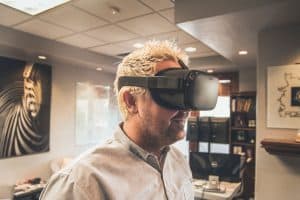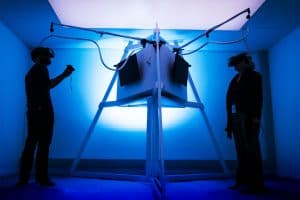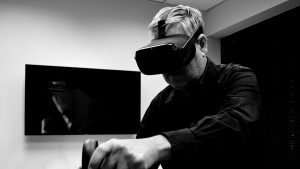Transform Business Collaboration Using Virtual Reality Technology
The Metaverse Explained
Media is abuzz about the metaverse. Big technology companies like Meta and Microsoft are investing heavily on it. Companies like Nike, Disney and Exxon are trying to capitalize on the frenzy. Chances are you are either looking to cash in on the metaverse boom or trying to figure out how metaverse can benefit your business?
But what is the metaverse? Is it a sensational new technology that Facebook introduced with their rebranding as Meta? Is it meant to be a digital twin of our universe, but without any boundaries or limitations? Or is it a rebranding of Extended Reality (XR) – an umbrella term for virtual reality (VR), augmented reality (AR) and mixed reality? More importantly, does the metaverse have potential to reinvent or transform your business?
The verdict’s not in if the metaverse will be the next big thing, but that doesn’t mean we should ignore it. First, understand that the metaverse is a work in progress and, second, learn to distinguish the hype from the real. If fully realized, the metaverse could become as important to companies as the Industrial Revolution. It would enable them to engage with their customers as well as their employees, partners and vendors in new, immersive ways.
But what is the Metaverse, really?
The metaverse is not a new concept. The metaverse proposes a connected digital environment where users can interact with others, have a digital twin of themselves through an avatar / character and transfer their belongings across multiple digital locations or ‘verses. Think about the metaverse as a digital universe with an infinite number of virtual worlds where you can roam freely from one world to another.
The metaverse, a blend of the words “meta” and “universe,” first came to attention in the 1992 science fiction novel Snow Crash. Since then the concept of the metaverse has been developed in virtual world platform games, such as Second Life and Minecraft. Metaverses (at this point there’s multiple ‘verses, not just Facebook’s) are designed to integrate virtual and physical spaces, even virtual money.
A metaverse is a network that allows users to place themselves in what appears to be a 3D virtual world with a focus on social interaction. In science fiction, it’s frequently used to describe a hypothetical iteration of the internet as a single, universal virtual world, entered through virtual reality or augmented reality devices. The metaverse won’t compete with the internet or replace it – it will extend it further. The internet is mainly a 2D medium for allowing users to communicate with each other, interact with websites and apps, and buy and sell goods and services. In the metaverse, users explore a 3D virtual world that mimics most aspects of the physical world.
The metaverse has many different features that will make it an exciting technology, including:
Endless – As an immersive virtual space, the metaverse is endless with no limits on users, activities, platforms and interactions.
Persistent – The metaverse cannot be paused or switched off. This will offer users continuity in their experience.
Immersive – Whether you’re using a VR headset, AR glasses, or a mobile device, you’ll receive an immersive and interactive experience.
Economies – Metaverse offers decentralized virtual economies powered by cryptocurrency for procuring digital products including merchandise, real estate, art and more.
Seamless – Metaverse will be seamless in user experience having connected platforms allowing users to move freely between ‘verses.
With current technologies, this connected experience across different metaverse platforms doesn’t exist and users remain confined within a ‘verse offered by the provider. Until these individual ‘verses become fully integrated, the metaverse will remain a concept.
For the metaverse to become reality, numerous improvements must be made across many connected systems. This doesn’t mean just how to get into the metaverse. It’s the technology that supports the metaverse. This includes advances in hardware, 5G network, cloud, mobility, artificial intelligence (AI) and blockchain.
Moreover, any risks associated with the metaverse for business must be mitigated to build trust and reduce the possibility of fraud and other issues. That includes how the digital economy and cryptocurrencies work. And regulations and laws governing the metaverse must be universally accepted by all who use it.
For now we recommend business leaders learn about the metaverse, while selecting related technologies they can successfully adopt. This includes immersive technologies, such as augmented reality (AR) and virtual reality (VR). Businesses can start experimenting with these technologies now as a way to make inroads into their metaverse journey – without going all in.
What makes the metaverse possible?
To start, a combination of several new technologies are needed. They include AR and VR headsets, which in recent iterations have come down in cost while providing more power and GPUs (graphics processing units). Other elements of the metaverse include blockchains, which offer smart contract functionality on a decentralized, open-source public ledger using a peer-to-peer network of computers and cryptocurrencies.
A cryptocurrency is a digital or virtual currency that is in principle impossible to counterfeit or spend more than once. The accounting takes place on a blockchain and cryptocurrencies are generally not issued by a central authority, which makes them theoretically free from government manipulation or interference.
Non-fungible tokens (NFTs) digitally represent digital assets such as digital artwork, digital real estate and other digital properties. They are trackable using a blockchain. What NFTs provide are new methods to purchase and, in a sense, to own digital goods, enabling creators to monetize their work.
Each NFT is unique and not divisible, while cryptocurrencies offer economic value and are fungible. In other words, one cryptocurrency token is worth the same value as another of the same currency.
Theoretically, token-holders can vote on how the platform is governed. This could foster economic opportunities, with digital goods and services untethered to a singular gaming platform or brand. Yet governments are likely to insist that their local laws and regulations are respected and that taxes are paid.
Moreover, the building of a metaverse requires a tremendous amount of resources and technology. The high-tech aspect of the metaverse has made it a buzzword that some brands use to exaggerate their progress in the sector and generate public relations stories.
Issues related to information privacy, user addiction and the safety of the metaverse have risen. These are similar to what the social media and video game industries faced. However, the intense immersiveness of the metaverse may make these issues that much more complex.
How does the metaverse work?
The idea that hundreds, if not thousands or millions, of people can take part in a shared, synchronous event is what’s promised in the metaverse. Currently, the technology to enable that level of experience does not exist. Participants in the metaverse are separated into shards, or sections, that cap how many avatars can fit in a server-defined area.
An avatar is a computer representation of a user in a computer-generated 3D world. You likely have seen avatars on social media, or websites and even on business websites to make customer support chatbots seem more human-like.
Reportedly, Fortnite’s 2019 Marshmello concert drew 10.7 million people (or avatars). But not all of them experienced it together. To accommodate that many people, the company created more than 100,000 instances – limited to 100 visitors per instance – of the concert. An “instance” is a concrete occurrence of an object existing at a specific time on a computer program. The technology has improved since and it’s likely a similar event could hold more today, but not 11 million at once.
There are companies attempting to develop shardless technology that can synchronously connect hundreds of millions of users to one another in a real-time, persistent virtual world. Some are promising that their code is 500 times more efficient than existing technologies, which if true may require 500 times fewer servers taking up resources. And if they’re successful, it still may not be enough.
An enormous reason is that the infrastructure requirements for the metaverse and internet are worlds apart. The internet was not designed for persistent communication, synchronized in precise real time, to countless others experiencing the same thing.
The metaverse is nothing like a large group of people simultaneously visiting a website. The metaverse is more similar to video conferencing and online games, where persistent connections update each other in real time and with a high degree of accuracy. But most video conferencing and games can’t accommodate such large numbers using existing internet technology.
Until there’s enough bandwidth to support the metaverse, enormous groups of people can’t experience a metaverse concert or other event in the same way that more than 70,000 people crowded into Levi’s Stadium IRL (In Real Life) to watch the Denver Broncos beat the Carolina Panthers in Super Bowl L (Super Bowl 50).
While the metaverse concept has existed since 1992, the technology to deliver a true metaverse experience is still in development. But that hasn’t stopped investment. The CEO of venture capital company Epyllion, Matthew Ball, said, “Even if you have more modest expectations, precedent from the digital economy, the internet [and] the mobile internet, suggests that this is a $10 [trillion] to $30 trillion opportunity that will manifest in a decade or decade and a half.” Mark Zuckerberg has mentioned that Meta is in for the long haul with their metaverse expedition, and he believes that the company’s investment in metaverse will flourish after 2030.
The metaverse is a journey that is worth exploring. At Invonto, we assist companies looking to venture into the metaverse or pre-metaverse-like applications, establish metaverse strategies for their business and get started with use cases that are feasible with current technologies. Many of these use cases leverage mixed reality, augmented reality and virtual reality for business collaboration, training, product support and virtual shopping. Interested in exploring metaverse strategies for your business? Contact us today to get started on your metaverse journey, or continue reading this article to learn more.
Exploring benefits of metaverse for business
The metaverse may offer a major opportunity for business-to-business and business-to-consumer companies. This includes new ways for audiences to engage with a company’s products and services as well as current customers and prospects and their spokespeople, in addition to educational and other experiences. Many of the current use cases may not deliver the full benefits the metaverse touts to offer, but that has not prevented many companies from making investments to keep up with technology advancements and not lose ground to their competition.
A virtual reality surgical training program in the metaverse would provide medical students with the ability to perform and master virtual operations in an immersive, interactive training experience before ever touching a human patient.
A virtual architecture program, like the one Invonto built for Merck, would allow architects and their customers to virtually enter and experience spaces so that they can fine-tune them before breaking ground.
A virtual manufacturing plant in the metaverse would enable a manufacturer seeking new parts to test them, providing more relevant information than looking at a physical brochure or a PDF with static 2D pictures.
A virtual showroom in the metaverse would let consumers interact with, compare, virtually try out and purchase products in a more immersive way than what can be experienced on a traditional website.
Branded consumer experiences and stores can be built in the metaverse. Nikeland, from Nike, provides an example. In its first five months, nearly 7 million people from 224 countries visited Nikeland since it opened in November of 2021. There users can try on virtual products and play games.
Business meetings can take place in virtual office spaces. The metaverse opens up the possibility of remote work, with avatars collaborating in digital spaces. But who says digital office spaces must look like traditional real-world offices? The technology could allow employees to choose or design their own office. It could be aboard a space station, on top of a mountain, or a hut on the beach. In a hybrid or remote work environment, virtual meetings can provide a better and more focused approach to business collaboration.
Virtual conference spaces in the metaverse are another application. The pandemic appears to show that conferences and events don’t have to be in-person to be effective. AR and VR technology enables companies to meet investors, buyers and other people in interactive 3D spaces from the comfort of their own homes.
Other opportunities may include providing remote assistance, immersive training, product demonstrations and scientific research.
Even though there needs to be further development to achieve the promise of what the metaverse for business can deliver, there are existing opportunities to use parts of the technology that forms, or will form, the metaverse. Here are some specific examples.
VR enables Merck to optimize a laboratory complex before breaking ground
Pharmaceutical company Merck wanted to ensure that the architectural plans of its new lab complex would deliver spaces optimized for research. To achieve this Merck engaged Invonto to develop an interactive and multi-user virtual reality application. The Invonto team transformed the blueprint of the lab environment and scientific processes into a realistic and immersive VR experience. This custom VR application enabled Merck’s stakeholders to virtually “work in the lab.”
The result: numerous suggestions for improvements that helped refine the floor plan of the lab and the design of scientific equipment before construction began. The app was also used to train new scientists and technicians in safety procedures and other lab protocols before they worked onsite.
While the VR application cost less than 2% of the total cost of the capital project, it saved Merck through avoiding the cost – not to mention the downtime – of renovating the labs after they were built. However, the amount saved in making the spaces more productive and efficient is incalculable.
“In my 30 years of experience in the construction field, this is the first time I was able to start punchlisting before we broke the ground. The virtual reality technology not only provided us a way to improve our plans, but it provided a space for us to collaborate with our vendors and train our employees on new business processes.” said John Roosa, Director, New Technology Development, Merck & Co.
AI and digital twin technologies enable BMW to optimize a factory
BMW used AI (artificial intelligence) and digital twin technologies to build a fully functioning, real-time digital twin of one of its factories. A digital twin is a virtual representation of a physical entity, such as a transportation system, a power plant or a factory. By simulating and modeling changes in the digital twin, a company can predict how the same changes will result in the real world.
BMW’s real-time digital twin can simulate at scale, production and scheduling based on instructions and robotics programming in the factory. This enables BMW to improve product quality, reduce manufacturing costs and unplanned downtime, while boosting output and ensuring worker safety. To achieve this requires massive amounts of meaningful data related to manufacturing operations, plus AI and machine learning technology to accurately model the data.
Speaking on behalf of the Board of Management of BMW AG, Milan Nedeljković said in regards to its factories that digital twin technology “revolutionizes BMWs planning processes.”
Augmented reality helps elevator technicians streamline repairs
Thyssenkrupp Elevator equipped its service technicians with a toolkit that uses the Microsoft HoloLens, which Microsoft refers to as “mixed-reality” technology. The device enables workers to visualize and identify problems before going onsite and provides remote, hands-free access to technical support.
According to CEO Andreas Schierenbeck, elevators move more than one billion people worldwide every day. Therefore anything that speeds up repairs reduces stress on passengers and elevator technicians. And tests demonstrate that the device enables repairs to be completed up to four times faster.
“Our goal is to dramatically increase efficiency, raise elevator uptimes and speed up service interventions to ensure mobility equipment is always running as it should, providing each passenger with the safest and most comfortable travel experience possible,” said Schierenbeck.
Blockchain can simplify the accuracy of medical and other supply chains
The Covid-19 crisis brought worldwide attention to the lack of transparency in medical supply chains. But the problem is not a recent one. A World Health Organization study showed that one in 10 medical products, from medicines to vaccines to diagnostic kits, are substandard or falsified in low- and middle-income nations. While a United Kingdom standards body estimated that pharmaceutical cargo theft costs more than $1 billion a year, with almost half of that occurring in the U.K. and U.S.
Using blockchain enables pharmaceutical companies and makers of healthcare equipment – along with their suppliers, distributors and customers – to track the provenance of drugs and supplies from end to end. It also allows competing companies to safely collaborate in a shared, permanent ledger without giving up control or revealing data. By ensuring trust, blockchains can rapidly reduce friction, mitigate fraud and assure product authenticity.
An example of such a blockchain is the MediLedger Network, which was established in 2019. The blockchain includes Gilead, Pfizer, Amgen, Genentech, AmerisourceBergen and McKesson, as well as retail pharmacies and transportation providers. The blockchain can verify the authenticity of a drug in less than one second. The same process without blockchain takes up to 48 hours.
How to get started today with your metaverse journey
Each of these examples illustrate opportunities your company could implement right now, without the need of a fully realized metaverse. The metaverse can benefit all aspects of business – from customers to employees and across the entire enterprise – while integrating cloud, mobile and artificial intelligence to extended reality, blockchain, digital twins, edge technologies and beyond.
The right path for getting started on your metaverse journey is to 1) identify appropriate use cases for emerging technologies that can deliver ROI and 2) develop a solution designed for adoption and outcomes.
As with any other app development project, the development of the metaverse and related applications starts with establishing your strategic goals. Gain a clear understanding of your business needs, what the metaverse means to your organization, and how the metaverse can benefit your business. Pick ideas that bring tangible benefits to the target audience. For example, you can create your own virtual space for collaborating within your business and with your customers. You can also create digital solutions for cloud, mobile and AI to get your business digital ready.
Here are some more ideas for creating metaverse applications:
- Marketplace for selling products
- Employee and customer training simulations
- Customer support application
- Social and team building applications
- New product R&D
As part of your strategy, you have to assess the readiness of your business to make your ideas a success. Does anyone on your team have experience or exposure to metaverse solutions? How will you onboard your employees and customers? Do you have IT infrastructure and management in place? Evaluating your business situation will help you pick ideas that might be easier to implement and offer tangible benefits.
Next, decide whether to hire your own team or hire an app development company. Metaverse technologies are evolving and require a skill set from technical artists and designers to app developers and testers. Unless you are ready to commit to a multi-year development plan, consider hiring an app development company. Hiring a team experienced with not just one part of the metaverse solution but has demonstrated expertise in cloud, mobile, AI, AR, VR and blockchain will help ensure your project remains on budget.
After your development team has built new digital solutions, focus on successful implementation. This will involve user training and onboarding, listening to user feedback and improving your products to increase user adoption and engagement. Measure outcomes of your new products against your initial success criteria to evaluate whether you are receiving strong ROI on your investments.
Conclusion
While metaverse has a potential for all businesses and it has become a hot topic in boardroom discussions, full implementation of the metaverse isn’t yet feasible. In the meantime, companies can get started with virtual reality, mobile, cloud and artificial intelligence solutions. While we are at the early days of the metaverse, it will advance very quickly. Exploring how your business could benefit from the available metaverse solutions can prepare you for future advancements. Moreover, including metaverse as part of your digital transformation strategies will help further your business transformation goals.
All of these complex technologies offer exciting opportunities, and a savvy development partner can help you succeed. At Invonto, we help our clients design and build enterprise metaverse and other emerging technology solutions, from strategy through launch. Our team includes product owners, cloud and mobile experts, machine learning engineers, technical artists and designers as well as augmented and virtual reality developers. Interested in learning more about the metaverse and its potential for your business? Let’s talk about what type of metaverse solutions may be the right fit for your business and how we can help you get started on your metaverse journey.



